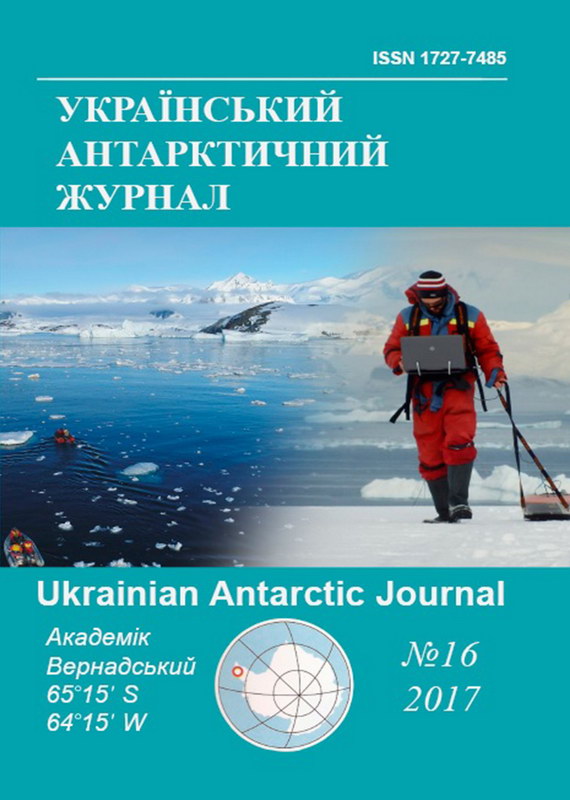- швидкість вітру,
- індекс,
- неоднорідність,
- південна кільцева мода,
- зміна клімату

Ця робота ліцензується відповідно до Creative Commons Attribution-NonCommercial-NoDerivatives 4.0 International License.
Анотація
Метою роботи є проведення аналізу режиму приземного вітру за даними Української антарктичної станції «Академік Вернадський» та його співставлення зі станом атмосферної циркуляції для розширення знань щодо регіонального клімату досліджуваного регіону. Використовувались традиційні методи кліматологічної обробки, кореляційний аналіз. Результати: за даними станції «Академік Вернадський» відзначається посилення швидкості приземного вітру в умовах підвищення температури повітря. Виявлена статистична неоднорідність в рядах швидкості вітру. Головним висновком є те, що підвищення температури повітря та посилення швидкості приземного вітру є єдиним проявом зміни клімату в регіоні дослідження, що відображає зміни в атмосферній циркуляції, насамперед – у посиленні зонального потоку і поглибленні циклогенезу в Антарктиці.
Посилання
- Atlas Antarktyky [Atlas of Antarctica]. L., Hydrometeoyzdat, 1969, 2, 600 .
- Hovorukha, L. S. 1997. Kratkaia heohrafycheskaia y hliatsyolohycheskaia kharakterystyka arkhypelaha Arhentynskye ostrova [Short geographical and glaciological characteristic of Archipelago Argentine Island]. Biulleten Ukraynskoho antarktycheskoho tsentra.[Bulletin of NASC]. K. 1997, 1, 17-19. https://doi.org/10.1016/S0045-8732(97)83155-5.
- Hruza, H. V. 1996. Klymatycheskaia yzmenchyvost povtoriaemosty y prodolzhytelnosty osnovnikh form tsyrkuliatsyy v umerennikh shyrotakh Severnoho polusharyia [Climatic variability of the frequency and duration of the main forms of circulation in the moderate latitudes of the Northern Hemisphere]. Meteorolohyia y hydrolohyia [Meteorology and hydrology]. 1996, 1, 12-22.
- Danylov, A. Y., Klepykov, A. V. 1970. Radyonov, V.F. 2000. Monitorynh sovremennikh klymatycheskykh yzmenenyi v Antarktyke [Monitoring of modern climate change in Antarctica]. Problemi Arktyky i Antarktyky, 72, 174- 196.
- Dzerdzeevskyi, B. L. 1981. Tsyrkuliatsyonnye mekhanyzmy v atmosfere severnoho polusharyia v 20 stoletyy [Circulation mechanisms in the atmosphere of the northern hemisphere in the XX century]. M., yzd. In-ta geografyy AN SSSR, 176.
- Martazynova, V.F., .Tymofeev, V.E, Yvanova. E.K, 2010. Atmosfernaia tsyrkuliatsyia yuzhnoi poliarnoi oblasty y klymat Antarktycheskoho poluostrova [Atmospheric circulation of Antarctica and climate of Antarctic Peninsula]. K.:Avers, 2010, 92.
- Repyna, Y.A., Yvanov, B.V., Kuznetsov, R.D. 2009. Rezhym vetra nad lednykovsmy sklonamy (po dannsm yzmerenyi na arkhypelahe Shpytsberhen) [The regime of wind over the glacial slopes (according to measurements in the Spitsbergen archipelago)]. Sovremennie problem dystantsyonnoho zondyrovanyia Zemly yz kosmosa [Modern problems of remote sensing of the Earth from space]. 2, 180-188.
- Tymofeev, V.E, Gordyenko, S.I., 1996. Mestnie tsyrkuliatsyy v raione ukraynskoi antarktycheskoi stantsyy [Local circulation of the Ukrainian Antarctic station region]. Biulleten Ukraynskoho antarktycheskoho tsentra. [Bulletin of NASC]. Kyiv. 1, 66-67.
- Begert, M., E. Zenkusen, C. Haeberli, C. Appenzeller and L. Klok. 2008. An Automated Homogenization Procedure; Performance Assessment and Application to a Large European Climate Dataset. Meteor. Z, 17(5), 663-672. https://doi.org/10.1127/0941-2948/2008/0314
- Field, C. B., V. Barros, T. F. Stocker, D. Qin, D. J. Dokken, K. L. Ebi, M. D. Mastrandrea, K. J.Mach, G. K. Plattner, S. K. Allen, M. Tignor, and P. M. Midgley (eds). 2012. Managing the Risks of Extreme Events and Disasters to Advance Climate Change Adaptation. A. Special Report of Working Groups I and II of the Intergovernmental Panel on Climate Change Cambridge University Press, Cambridge, UK, and New York, NY, USA. 582.
- Franzke, C. 2013. Significant Reduction of Cold Temperature Extremes at Faraday/Vernadsky Station in the Antarctic Peninsula. Int. J. Climatol, 33, 1070 - 1078. https://doi.org/10.1002/joc.3490.
- Gillett, N. P., Kell, T. D., Jones, P. D. 2002. Regional Climate Impacts of the Southern Annular Mode. Geoph. Res. Letters, 33, L23704, https://doi.org/10.1029/2006GL027721.
- Hall, A., Visbeck, M. 2002. Synchronous Variability in the Southern Hemisphere Atmosphere, Sea Ice, and Ocean Resulting from the Annular Mode. J. Climate, 15, 3043-3057. https://doi.org/10.1175/1520-0442(2002)015<3043:SVITSH>2.0.CO;2.
- Hinzman, L., Bettez, N., Bolton, W. R. et al. 2005. Evidence and Implications of Recent Climate Change in Northern Alaska and Other Arctic regions. Climatic Change, 72, 251-298. https://doi.org/10.1007/s10584-005-5352-2.
- Julie M. Arblaster, G. A. Meehl. 2006. Contributions of External Forcings of Southern Annular Mode Trends. Journal of Climate, 19, 12, 2896-2905. https://doi.org/10.1175/JCLI3774.1.
- Klok, E. J., A. M. G. Klein Tank, 2009. Updated and Extended European Dataset of Daily Climate Observations. Int. J. Climatol., 29, 1182, https://doi.org/10.1002/joc.1779.
- Marshall, G. J, Battista S., Naik S. S., Thamban, M. 2011. Analysis of a Regional Change in the Sign of the SAM - Temperature Relationship in Antarctica. Climate Dynamics, 36, 277-287. https://doi.org/10.1007/s00382-009-0682-9.
- Meteorology of Falkland Islands and Dependencies. London, 1954. 250.
- Morozova, A.L., Valente, M. A., 2012. Homogenization of Portuguese Long-term Temperature Data Series: Lisbon, Coimbra and Porto, Earth Syst. Sci. Data, 4, 187-213, https://doi.org/10.5194/essd-4-187-2012.
- Project team ECA&D, Royal Netherlands Meteorological Institute KNMI September 16, 2013. Algorithm The oretical Basis Document (ATBD) Project number: EPJ029135.
- Steffensen, P., F.L. Larsen, J. Cappelen, 1993. Homogeneity Test of Climatological Data. DMI Technical Report. 93-12.
- Turner, J. 2004. The El-Nino and Antarctica. Int. J. of Climatol, 24, 1-32. https://doi.org/10.1002/joc.965.
- Turner, J., Colwell S., Marshall G., Lachlan-Cope T., Carleton A., Jones P., Lagun V., Reid F., Iagovkina S. 2005. Antarctic Climate Change During the Last 50 years. Int. Journal of Climatology, 25, 279-294. https://doi.org/10.1002/joc.1130.
- Turner, J.,Marshall G.J, Lachlan-Cope T. 1998. Analysis of Synoptic-scale Low Pressure Systems Within the Antarctic Peninsula Sector of the Circumpolar Trough. Int. J. Climatol., 18, 253-280. https://doi.org/10.1002/(SICI)1097-0088(19980315)18:3<253::AID-JOC248>3.3.CO;2-V
- Tymofeyev, V. 2009. On the Role of Tropospheric Circulation in the Recent Climate Change in the Antarctic Peninsula Region. Bulletin of Geography. Physical Geography Series (Poland), 1, 63-75. https://doi.org/10.2478/bgeo-2009-0004.
- Van den Besselaar, E.J.M., A.M.G. Klein Tank, G. van der Schrier, 2010. Influence of Circulation Types on temperature Extremes in Europe. Theor. Appl. Climatol., 99, 431-439. https://doi.org/10.1007/s00704-009-0153-6.
- Van Lipzig, N. P. M., King, J. C., Lachlan - Cope T. A. 2004. Precipitation, Sublimation, and Snow Drift in the Antarctic Peninsula Region from a Regional Atmospheric Model. J. of Geoph. Res. 2004, 109, D 24106-D24112. https://doi.org/10.1029/2004JD004701.
- Wenju Cai, Tim Cowan. 2007. Trends in Southern Hemisphere Circulation in IPCC AR4 Models over 1950-99: Ozone Depletion versus Greenhouse Forcing Journal of Climate. J. Climate, 20, 4, 681-693. https://doi.org/10.1175/JCLI4028.1.

